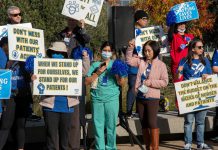When President Bush signed a $555 billion appropriations bill
aboard Air Force One Wednesday, he tacitly approved $482,890 to
help Gilroy’s homeless and low-income residents find shelter and
medical care, all thanks to Mike Honda.
When President Bush signed a $555 billion appropriations bill aboard Air Force One Wednesday, he tacitly approved $482,890 to help Gilroy’s homeless and low-income residents find shelter and medical care, all thanks to Mike Honda.
Honda (D-San Jose) represents the 15th Congressional District, which includes Gilroy, Cupertino, Milpitas, Santa Clara, Campbell, Los Gatos and parts of San Jose. As a member of the House of Representative’s money-wielding Appropriations Committee, Honda helped steer much of the $555 billion after three months of debate between Democrats and Republicans in the House and Senate.
Gilroy’s nearly $500,000 is part of a much larger $43 million Honda tagged onto the spending bill for more than 30 Santa Clara County initiatives. These included the Santa Clara County Crime Lab, the Santa Clara Valley Transportation Authority, the Housing Trust of Santa Clara County, county health clinics, gang prevention programs and environmental restoration projects.
The two Gilroy recipients are the Emergency Housing Consortium’s Sobrato Transition Center, a homeless shelter planned for north Gilroy that will receive $196,000, and the Gardner South County Medical Center located in downtown Gilroy, which will receive the remaining $286,890.
Gilroy Mayor Al Pinheiro welcomed the federal funds – part of nearly $8 billion spread among 12,000 pork-barrel expenditures nationwide that President Bush decried as wasteful. Pinheiro said he hoped the medical center would fill empty building space with a pharmacy.
Gardner’s Chief Executive Officer Reymundo Espinoza oversees the nonprofit’s 12 locations in the county. He confirmed that all the federal money would finance the construction of a new 1,000-square-foot pharmacy that will offer prescription drugs for as low as $5 to $10 per month to qualified patients.
Wendy McDonald of Morgan Hill praised the idea.
The low-income resident has visited the Gilroy clinic at the corner of Monterey and Fifth streets for about three years, she said. She has to find a ride down to the clinic for a regular checkup Wednesday afternoon, and another ride to San Jose to get discounted prescriptions, she said. Having her doctor and a pharmacy in the same building would save her time, she said.
“I could get it all in one stone,” McDonald said. “It would be a great idea to open the pharmacy for the people who don’t have transportation. It would be so convenient.”
McDonald is not alone either.
The Gilroy area was identified as the highest need area in Santa Clara County in a 2005 United Way study that found an estimated 22,000 low-income people in need of health services. There are about 7,200 homeless people in the county, according to the 2007 Santa Clara County Homeless Census and Survey. U.S. Census figures estimate the county population at 1.75 million.
Understanding what low income means in Gilroy means understanding that the median household income in Santa Clara County is $78,000; California’s is $50,000; and it’s $40,000 nationwide, according to U.S. Census figures.
The United Way used these numbers to create a color-coded map according to per capita income levels throughout the county, with $13,000 being the lowest average and $43,000 being the highest average. Parts of downtown San Jose, north Mountain View and nearly all of Gilroy appear in red, representing the high concentration of low-income residents in the three areas. Yellow and green shades cover Morgan Hill and most other cities on the map.
“If you look right behind downtown (Gilroy) on both sides, that’s all low-income folks that need help,” Espinoza said. “(Rep. Honda) knows the need that exists in Gilroy for these types of services.”
Within the Appropriations Committee, Honda serves on the Commerce, Justice and Science subcommittee; the Labor Health and Human Services subcommittee; and the Legislative Branch subcommittee. Honda could not be reached for comment Thursday, and a spokesperson for EHC did not return messages for comment.
The funds for EHC’s transitional center, though, will support the creation of the new, 140 bed multi-service facility that will provide 75 emergency shelter beds and 65 transitional beds for homeless adults and families. The center will also offer meals, medical services, vocational services, computer education and parenting workshops for about 2,200 individuals per year, according to a press release from Honda’s office.
Espinoza said the 30-year-old nonprofit’s relationship with Honda goes back to the congressman’s days as a county supervisor in 1990.
All the while, Espinoza said Gardner’s operations have relied on munificence from Gilroyans to Washington politicians, and that he looked forward to expanding commercial operations here with the new pharmacy that will also be open to the public.














